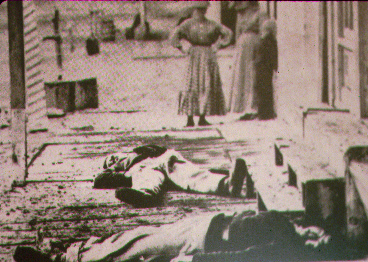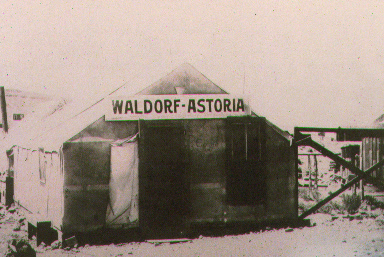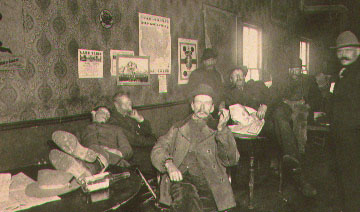|
Tahoe Nugget #78:
Morning Call in the Saloon
May 25, 2000
Their labels were telling. Drinking Red Dynamite would "blow your head off." Block and Tackle made a man "walk a block and tackle anything." Forty Rods dropped the drinker at exactly that distance from the bar. The
debilitating effects of Taos Lightning struck a man on the spot. There were so many alcoholic concoctions in the saloons of the frontier West, that every customer could chose his own poison.
For those
settlers, miners and prospectors living on the east slope of the Sierra Nevada, the local drink of choice was "Tarantula Juice." This home-brewed beverage imparted a nasty "bite" due to the strychnine added to it.
Strychnine is a poison and kills quickly in lethal doses, but in the early 19th century French scientists had promoted a diluted strychnine/prussic acid mixture as a cure for pulmonary disorders.
In Carson Valley, traders purchased a strychnine solution in Placerville and then added it to what they called "gin." Carson Valley "gin" was wood grain alcohol made from turpentine, oil of vitriol, rosin and essence of laurel. Sometime around 1852, local Nevada fiddle player "Dutch Nick" Ambrose added prussic acid as well as tobacco oil to his concoction and called it Tarantula Juice. Strychnine is an alkaloid and probably produced an effect similar to the drug methamphetamine. The erratic bursts of nervous energy coupled with heavy alcohol consumption often resulted in violence. The moniker "Tarantula" alluded to more than the drink's bite.
Early western drinks were often homemade, the kind that "never paid no taxes." As the male population boomed, so did the number of saloons ready to slake their thirst. The saloon was all things to all men. Besides being a drinking establishment, it was often an eatery, a hotel, a bath and comfort station, a livery stable, gambling den, dance hall, bordello, barbershop, courtroom, political arena, dueling ground and undertaker's parlor.
The saloon is as American as apple pie. Benjamin Franklin tipped the bottle frequently; John Hancock was a rumrunner while George Washington drank hot toddies in countless taprooms and ran up enormous liquor bills. Thomas Jefferson promoted home brewing of native malt. Daniel Webster was "as majestic in his consumption of liquor as in everything else." Taverns and saloons are an American tradition.
Saloons in the West drew men like a magnet. One old timer reminisced, "We was weaned on it. The saloons were mighty popular places. We thought nothing of riding thirty miles just to have a drink." For some of the early prospectors and pioneers whiskey came before food, women, even gold. The saloon was often the first building up in a new community and the last to close before it became a ghost town. The saloon was the best place for socializing and conducting business, and the barkeep was one of the most respected citizens in town. Mark Twain wrote, "The cheapest and easiest way to become an influential man and be looked up to by the community at large, was to stand behind a bar, wear a cluster-diamond pin, and sell whiskey." After his days in Virginia City, he added, "I am not sure but that the saloon keeper held a shade higher rank than any other member of society. His opinion had weight. It was his privilege to say how elections should be run. No great movement could succeed without the countenance and direction of the saloon keeper."
In 1860, the total population of Virginia City was 2,390, only 118 of whom were women. Without the restraining influence of "respectable women," miners often drank until they passed out. In most saloons, wayfarers who had spent money on drink were allowed to sleep on the sawdust floor. Morning call would often find many itinerant customers still asleep on the chairs, tables and windowsills.
Photo #1: The combination of armed men and alcohol contributed to a high rate of violent deaths on the frontier.
Photo #2: The saloon was often one of the first businesses to open and the last to close.
Photo #3: Morning call in an Elko, Nevada saloon in 1907.



|





